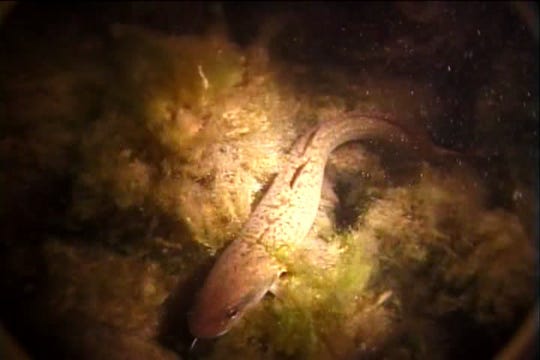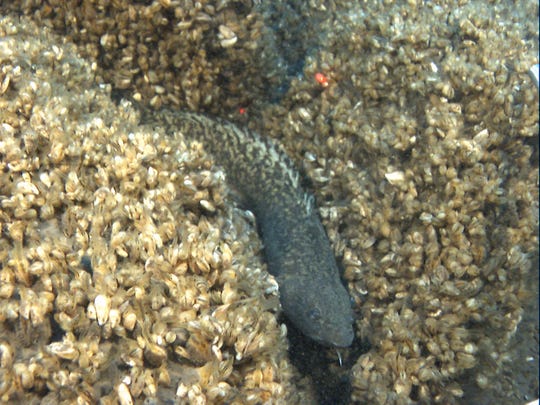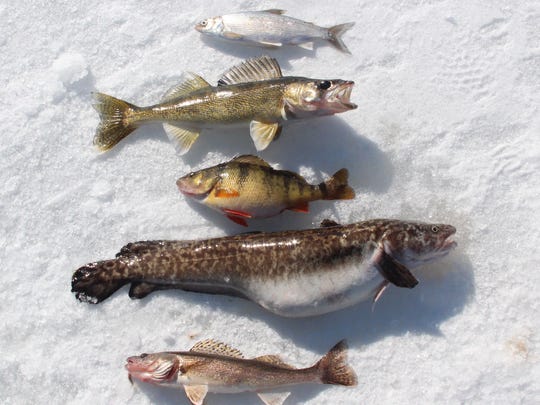Call it burbot, eelpout or lawyer, this native fish deserves our respect
Jan 12, 2019 07:32AM ● By Editor
A burbot is landed by an ice fisherman. The species, also known as eelpout and lawyer, is a top predator fish and is native to Wisconsin waters and the Great Lakes. Photo: Paul A. Smith
By Paul A. Smith from the Milwaukee Journal Sentinel - January 11, 2019
Some people consider the burbot the "Rodney Dangerfield" of the fish world.
With a flattened head and eel-like body, it doesn't win many beauty contests. And too often it gets "no respect," as the comedian famously said of himself.
Further, consider this: One of the fish's nicknames is lawyer, a reference many believe is linked to its slimy skin and slippery nature.
But if you get beyond looks and an unfounded reputation as a "trash" fish, the burbot takes on an entirely different – and truer – character.
In fact I'd argue the native species should be regarded as highly as any fish in Wisconsin.
I get to thinking about burbot this time of year because it's when I've encountered them most. The species spawns in winter (mostly) and is known to make runs out of lakes and up rivers to reproduce.
Every few years I make a trip in January to the St. Louis River west of Superior, Wisconsin, to ice fish for them.
I consider the fish an angler's delight. They hit aggressively, fight hard and provide excellent table fare.
Not all fishermen see them the same way, however. It's common in some places for burbot to be caught and discarded on the ice.
Regulations in Wisconsin and several other states haven't done the species any favors. The Department of Natural Resources fishing pamphlet lists burbot as a rough fish, with no protections such as closed seasons, bag limits or restrictions on methods of take.
Every so often I'll catch one while fishing in winter in the Milwaukee harbor or Milwaukee River. I consider such events happy accidents.
But the presence of burbot in Milwaukee waters and elsewhere is not by chance – the species is a survivor.
And while other Great Lakes fish have been assisted by expensive stocking programs and restoration efforts after they were thrashed by pollution, habitat loss and invasive species over the last two centuries, the burbot has made it all on its own.
Yes, this fish – whether you call it burbot, lawyer, eelpout or lingcod – deserves to be best known for its many merits.

A burbot swims at night along the bottom of Lake Michigan. Photo: Photo courtesy of John Janssen, UWM School of Freshwater Sciences
"They are wonderful fish," said Dave Jude, a professor emeritus at the University of Michigan and veteran of more than four decades of fisheries research on Lake Michigan. "Little known, perhaps, but with a large ecological role in the history of the lake."
Burbot have a large, wide mouth, with small teeth on both jaws, and mottled, smooth skin. The long, low dorsal fin runs to the tail, giving the fish the look of an eel.
The burbot also features a single barbel on its chin, giving it a hipster appearance. The anatomical feature helps the fish detect prey.
Burbot are most active after dark and spend most of their time in the benthic zone, or near the bottom, of lakes and rivers.
In Wisconsin, burbot are found widely, including Lake Michigan, Green Bay, Lake Superior and the Winnebago system as well as the St. Croix, Mississippi and Wisconsin river drainages, according to "Fishes of Wisconsin" by George C. Becker.
In parts of their range, burbot are reported to weigh as much as 60 pounds. The Wisconsin record burbot was a 37.8-inch fish that weighed 18 pounds 2 ounces; it was caught in 2002 in Lake Superior.
Jude said he often starts fisheries lectures by citing Lake Michigan's top two native predator fish – lake trout and burbot.
"They were found throughout the Great Lakes when Europeans first settled in the region," Jude said. "Before any salmon were introduced, the burbot was one of two species that ruled the region. Very impressive fish."

Eric Geisthardt, then a graduate student at the UWM School of Freshwater Sciences, holds a burbot during an August, 2017 dive on Green Can Reef in Lake Michigan near Milwaukee, Wisconsin. Photo: UWM School of Freshwater Sciences
Burbot claim a number of distinctions in the fish world.
For starters, they are the only freshwater member of the cod family.
The burbot (Latin name Lota lota) is found in waters around the crown of the planet, including Canada, Russia and Scandinavia.
Like its salt water cousins sold in markets worldwide, the burbot features delectable, white flesh.
Very little commercial fishing of burbot occurs in North America, however.
One commercial fisherman who has tapped into the burbot resource is Ken Koyen in Door County. Koyen catches burbot year-round in the cold waters of Lake Michigan and serves them at his restaurant, KK Fiske, on Washington Island.
The window at KK Fiske bears a sign that advertises "Fresh Lawyers."
My favorite burbot recipe is to cut the meat into 1-inch cubes and drop the pieces into boiling 7-Up. After about a minute, remove the fish and serve with drawn butter.
One taste and you'll know why burbot is also called "poor man's lobster."
Jake Vander Zanden, a fisheries professor at UW-Madison, used to catch an occasional burbot in his youth while fishing on Lake Winnebago.
"It's a species that people don’t really pay attention to, but it's really a pretty remarkable fish," Vander Zanden said.
Vander Zanden has documented burbot in several studies over his career.
"It's a top predator, for sure, and it eats a super wide range of other fish as well as crustaceans," Vander Zanden said.
During one project in Quebec, Vander Zanden learned to cook burbot by wrapping a whole (gutted) fish in foil, cooking it at 355 degrees for 25 to 30 minutes, and then, after slight cooling, peeling the skin off.
"The meat just pulls off the bones and it's delicious," Vander Zanden said.
Burbot is also remarkable for its reproductive habits. It's the earliest spawning fish in Wisconsin, according to Becker.
And it's one of only three Great Lakes fish to breed in winter, Jude said. The others are the bloater chub and deepwater sculpin.
But John Janssen of the UWM School of Freshwater Science also found evidence of burbot spawning later in the year.
Using a submersible on the mid-lake reef in Lake Michigan, Janssen picked up just-hatched burbot larvae in summer.
"No one expected that," Janssen said. "It showed that burbot not only use different areas to spawn, including the rivers people knew about but also offshore reefs, but also that they reproduce later in the year than we knew."

A burbot swims in a quagga mussel-lined crevice on the Lake Michigan bottom. Photo: Photo courtesy of John Janssen, UWM School of Freshwater Sciences
Such versatility can be the key to a species survival.
Turns out the burbot is a bit of an ecological ninja.
While lake trout were basically wiped out by sea lampreys in the 20th century, requiring extensive stocking to help restore the species, the burbot was buffeted but unbeaten.
It not only survived the onslaught of invasive species over the last 75 years, but has adapted in the face of change.
Diet studies in the last two decades have shown burbot feed heavily on the round goby, an invasive species that has inundated nearshore habitat in Lake Michigan and spends much of its time near the bottom.
"Burbot just vacuum the gobies up," Jude said. "They are responding to a new opportunity."
Burbot have been embraced by local culture in parts of its range, too.
The biggest and arguably most well-known fete of the species is the International Eelpout Festival on Leech Lake in northern Minnesota.
Held for the last 40 years, the three-day event draws more than 10,000 people to tiny Walker, Minnesota (pop. 1,069).

A selection of fish caught on an ice fishing outing on Lake of the Woods, Minnesota included (top to bottom) tulibee, walleye, yellow perch, burbot and sauger. Photo: Paul A. Smith
This year's gala, which awards prizes for the biggest 'pout catches as well as "team tonnage," is scheduled Feb. 21 to 24.
To read more on this story and see related reporting, follow this link to the Journal Sentinel website. https://www.jsonline.com/story/sports/columnists/paul-smith/2019/01/11/smith-burbot-native-great-lak...

